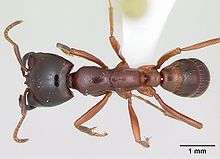Dorylinae
| Dorylinae | |
|---|---|
 | |
| D. gribodoi | |
| Scientific classification | |
| Kingdom: | Animalia |
| Phylum: | Arthropoda |
| Class: | Insecta |
| Order: | Hymenoptera |
| Family: | Formicidae |
| Subfamily: | Dorylinae Leach, 1815 |
| Type genus | |
| Dorylus Fabricius, 1793 | |
| Diversity[1] | |
| 28 genera | |
Dorylinae is an ant subfamily with distributions in both the Old World and New World. In 2014, Brady et al. synonymized the previous dorylomorph subfamilies (Aenictinae, Aenictogitoninae, Cerapachyinae, Ecitoninae and Leptanilloidinae) under Dorylinae.[2]
Genera
- Acanthostichus Mayr, 1887
- Aenictogiton Emery, 1901
- Aenictus Shuckard, 1840
- Cerapachys Smith, 1857
- Cheliomyrmex Mayr, 1870
- Chrysapace Crawley, 1924
- Cylindromyrmex Mayr, 1870
- Dorylus Fabricius, 1793
- Eburopone Borowiec, 2016
- Eciton Latreille, 1804
- Eusphinctus Emery, 1893
- Labidus Jurine, 1807
- Leptanilloides Mann, 1923
- Lioponera Mayr, 1879
- Lividopone Bolton & Fisher, 2016
- Neivamyrmex Borgmeier, 1940
- Neocerapachys Borowiec, 2016
- Nomamyrmex Borgmeier, 1936
- Ooceraea Roger, 1862
- Parasyscia Emery, 1882
- †Procerapachys Wheeler, 1915
- Simopone Forel, 1891
- Sphinctomyrmex Mayr, 1866
- Syscia Roger, 1861
- Tanipone Bolton & Fisher, 2012
- Vicinopone Bolton & Fisher, 2012
- Yunodorylus Xu, 2000
- Zasphinctus Wheeler, 1918
References
- ↑ Bolton, B. (2016). "Dorylinae". AntCat. Retrieved 19 October 2016.
- ↑ Brady, Seán G; Fisher, Brian L; Schultz, Ted R; Ward, Philip S (2014). "The rise of army ants and their relatives: diversification of specialized predatory doryline ants". BMC Evolutionary Biology. 14: 2–14. PMC 4021219
 . PMID 24886136. doi:10.1186/1471-2148-14-93.
. PMID 24886136. doi:10.1186/1471-2148-14-93.
External links
 Media related to Dorylinae at Wikimedia Commons
Media related to Dorylinae at Wikimedia Commons
This article is issued from
Wikipedia.
The text is licensed under Creative Commons - Attribution - Sharealike.
Additional terms may apply for the media files.